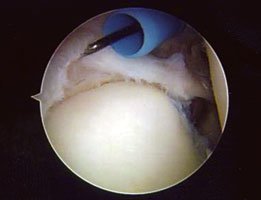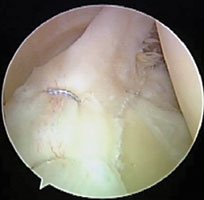Combining SLAP and cuff repair depends on labral attachments, shoulder stability
Type II lesions in overhead athletes and lifters should be fixed without biceps overconstraint.
Performing arthroscopic repair of superior labral anterior posterior or SLAP lesions in conjunction with fixing torn rotator cuffs may not always be warranted in patients with shoulder pain and instability, according to a Los Angeles sports medicine specialist.
Neal S. ElAttrache, MD, said little is known about the labral anatomy and how it functions, which makes the decision of whether to also do a SLAP (superior labrum anterior-posterior) lesion repair a difficult and multifactorial one.
“Take a look at the morphology,” he said. Use it as a guide when determining the significance of a SLAP tear and whether it is the pain generator.
About 50% of the time a predominant, well-described morphology is involved, making it an easier decision. Otherwise, find out through the examination and arthroscopy where the structural stabilizers are attached and if the patient absolutely needs a functioning labrum, ElAttrache said at Orthopedics Today Hawaii 2009.
|
Images: Trace R |
ElAttrache encouraged clinicians to choose wisely when doing combined arthroscopic SLAP and rotator cuff repairs because they can reduce shoulder motion, increase intra-articular joint pressure or produce other consequences.
“Take a look and see where the most robust stabilizing structures are attached. This will help you figure out how important the labrum is in that patient,” ElAttrache said.
If the labrum is not important, he recommended not fixing it.
Painful shoulders in athletes, whose upper extremity traction and weight-bearing is extreme as in climbers or weightlifters, often a result from biceps superior labral complex injuries. These nearly always need to be repaired, especially in young athletes, ElAttrache said.
Type I, II lesions
For type I SLAP lesions, where labral fibers are frayed due to degeneration but most of the medial fibers remain attached to the glenoid, ElAttrache uses debridement.
That is also his preferred approach for small flaps. “I test for labral stability afterwards,” he said.
With increased fiber fraying and detachment, as with type II tears, ElAttrache looks for signs of labral avulsion and an abnormal cartilage surface. He said he may then only fix those lesions in one direction, such as anteriorly, if indicated: “I do not want to over-constrain the biceps. I just simply want to provide this ligament with a bony attachment again.”
When fixing the labrum, “I anatomically restore the labral attachment,” ElAttrache said. Therefore, he repairs large bucket-handle tears to avoid losing too much labral tissue, but debrides smaller bucket-handle tears.
Significant instability
ElAttrache said he most commonly repairs type II SLAP lesions in which the labral fibers and biceps complex are detached at the superglenoid tubercle, especially when the tear is large enough to permit medial displacement of the labrum — peel back — with shoulder rotation or the tear involves the superior or middle glenohumeral ligament attachments.”
|
|
Images: ElAttrache NS |
In his hands, nearly everyone with significant instability undergoes arthroscopic SLAP II repair in conjunction with repair of their rotator cuff tear. ElAttrache’s preferred labral repair technique: inverted vertical mattress suturing with nonbiodegradable sutures (Figure 1b). He said it produces a lasting repair and permits hiding the knots inside the joint.
Should the significance of a labral tear ever be in doubt, ElAttrache looks elsewhere for the pain generator, including the subacromial space, the acromioclavicular and glenohumeral joints, and the rotator cuff. Problems in any of these areas can mimic the same glenohumeral loading pain produced by a superior labral tear.
“Rotator cuff pathology is a source of pain in many athletes,” he said.
For more information:
- Neal S. ElAttrache, MD, can be reached at Kerlan-Jobe Orthopaedic Clinic, 6801 Park Terrace Drive, Ste. 500, Los Angeles, CA 90045-1539; 310-665-7257; e-mail: elattrache@aol.com. He receives research grants and royalties from Arthrex.
Reference:
- ElAttrache NS. SLAP repairs: Should I fix with cuff repair? Presented at Orthopedics Today Hawaii 2009. Jan. 11-14, 2009. Kohala Coast, Hawaii.



